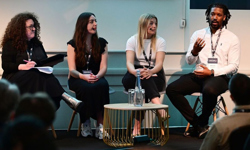
When Facebook bought Instagram for $1 billion in April 2012, the world, including investors, thought the move was a crazy one. At the time, Instagram was only a couple of years old, with no real business model and no revenue. Although its 30 million users at the time meant that Instagram was nothing to shake a stick at, Facebook did not take its time creating new ways to monetise the network. Now at 500 million users just four and a half years later, 14 million of whom are in the UK, and estimated to have brought in $3.2 billion in 2016, according to Bloomberg, Instagram has proved to be a good investment for Facebook, not least because the latter has established Instagram as a good platform for publishers, too.
If you're not familiar with Instagram, it is a photo-sharing application that is similar to Facebook but solely focused on the mobile experience and sharing photos and videos in real time. Unlike Facebook, where your newsfeed may be a combination of text messages, photo messages, video messages, or shared content, Instagram focuses solely on visual content with an emphasis on photography and photo filters. A user can upload one photo at a time with a description of the photo. Instagram has recently introduced live video and "stories" similar to Snapchat's system. With stories, users can take videos throughout the day and post them to their daily "story", which pieces all the clips together. After 24 hours, clips disappear. Instagram also recently launched live video, so users can stream live from their phones to their followers who get push notifications when a friend is live.
Major newspaper and entertainment publishers like the Guardian, Business Insider UK and The Sun have been experimenting with live video. While it's mostly been through live-streaming platforms like Periscope or Facebook Live, it's likely they'll move into Instagram, too.
Instagram does come with some challenges for publishers. You'll find that Business Insider UK and others have had success selling native advertising packages of branded content, one client being General Electric. However, the way publishers are traditionally used to using social networks is to promote content on their blogs and digital portals, but Instagram isn't built for self-promotion, and hyperlinks don't work when you post them with images.
This is probably the reason why advertisers have seemingly been flocking to Instagram: there's no easy way to hyperlink within a post unless you pay for that functionality. Otherwise, the way publishers get around this is by saying ‘Click the link in our profile’, but this strategy requires changing the link in your profile every time you post a new image, and also makes all previous posts obsolete.
With that in mind, there are numerous ways to use Instagram for brand awareness, advertising and even organic traffic.
1. Promoted Content Using Shortlinks
As mentioned, it's not easy to promote your blog content on Instagram. It offers no SEO value and hyperlinks in posts can't be clicked. However, that doesn't mean you can't promote content when you feel it's important or necessary, like a featured article, or a follow-up article to a behind-the-scenes photo you posted the week before. It's not uncommon for users to ask for a link. This is especially true if you're a cooking magazine posting photos of recipes that users will want. Sometimes, it's easiest to say that the article is featured on the homepage of your blog (with a link in the profile), or post the actual link in your profile and point to it. But, a backup plan is to use a link shortener like bitly.com that will allow you to create custom short links. For example, let's say your newest issue comes out, and you're sharing the feature article on the blog. You could post an image of the cover letting people know the featured article is live with a short link that says bit.ly/magnamemarch2017. Users will still need to type it in, but it's a heck of a lot easier to remember and manually type in than a full permalink.
2. Contests That Leverage User-Generated Video Content
Create contests that ask users to create videos of them reading your magazine using a specific hashtag. Then, piece the videos together and publish the finished product on Instagram. There's nothing millennials enjoy more than creating content for social media, and they are active participants in online challenges and contests where their videos have an opportunity to be featured. Don't forget to shout out their @ handle in the post.
3. Behind-the-scenes Footage and Photos
Post behind-the-scenes photos and videos during magazine interviews. For the content that isn't written through email interviews and phone calls, make sure you have an intern or marketing person ready to snap photos and videos. Creating a series of these that get released weeks and days before a new issue can build buzz, improve engagement, and increase newsstand and subscription sales.
4. Targeted Photo, Video, and Carousel Ads
Instagram appears to have nailed down targeted ads to a science, thanks to Facebook. This may be because hashtags are so prevalent and help categorise people's likes and dislikes so well on the network, and the ads allowed by Instagram and delivered to users seem to be the most well tolerated among all the social networks and even enjoyed by their users. For this reason, the organic approach to getting free traffic from social networks should always be priority #1. Instagram ads may be a worthwhile investment for publishers, and their ad backends will be familiar if you've ever purchased Facebook ads. You can now promote your Facebook content through Instagram.
5. Co-Created Advertiser Content
Have you already started to create content through Instagram? Are people engaging and do you have good metrics to show advertisers? There is nothing advertisers love more than partnering with a publisher that has the resources to create compelling content and distribute it. Begin by testing the waters with one of your most adventurous advertisers and, then, create a workflow and package you can bundle for existing and future advertisers.
6. Hashtagged Content
Hashtags are abundant on Instagram, and while on other social networks, they may seem overused or not entirely relevant, you'll find that Instagram users are actively looking at content by clicking on hashtags. So, for example, if you were working for a boating magazine and were posting a photo of a schooner, you would be wise to use even the most basic hashtags, such as ‘#boating’, ‘#boats’ and ‘#schooner’, and even fun ones, such as ‘#iloveboats’, ‘#boatlover’ and ‘#schoonerorlater’. There are over a million photos that use the hashtag ‘#boatlife’. Don't look on those million as competition, either, because the number shows there are over a million users actively using a hashtag and even more who could be following those users and engaging with the hashtag. You can use up to 30 hashtags in an Instagram post, and a test by Social Media Expert Louise Myers found that posts with 11 or more hashtags had 442% more engagement than those with none.
7. Local-Focused Content
Regional magazines have a bonus opportunity, and that's tagging local businesses in posts and leveraging local hashtags. Sponsors such as local restaurants will be especially happy with this strategy when you promote their restaurants using their @ handles and hashtag the heck out of your local city with hashtags like ‘#london’, ‘#londonlife’, ‘#londonrestaurants’ and ‘#londonfood’.
8. Shoot Teaser Clips About Upcoming Issues
While you could do this with every new article you want to promote, it could prove to be even more useful for promoting new issues. Find someone who typically acts as a face or spokesperson for your magazine. This could be your managing editor or someone who is prominently known as your social media person. Shoot them previewing the new issue, much like a book trailer. You can have them on screen talking or flip to different photos from the issue. Give backstories about shoots and tell stories about interviews with the different celebrities and / or experts. Try to build buzz leading up to the release and build loyalty by putting a face to your Instagram account.
If you're trying to decide if Instagram is a platform you want to spend time and money on, consider some stats:
* 30% of 16-64 year-olds around the world are on Instagram (Global Web Index)
* 65% of daily active Instagram users are female vs 35% male (eMarketer)
* 32% of Instagram users have attended college or graduated (Pew Research Center)
* 32% of Instagram users live in cities (Pew Research Center)
* Income of Instagram users is spread pretty evenly across the board (Pew Research Center)
* 27% of teens say Instagram is their most important social network (Piper Jaffray's bi-annual ‘Taking Stock With Teens’ survey)
* Users spend 20 minutes per day on Instagram (SimilarWeb)
It appears that since only 4% of people over the age of 64 use Instagram, according to Pew, it may be a better social network for anything but Saga magazine. But you can tell that to my grandmother, who has the long-standing record of being the only person to like every single one of my Instagram posts. My vote? I think Instagram is applicable to just about everyone, but if you have an audience that is primarily millennials, you will find them there, and hopefully they will find you.












